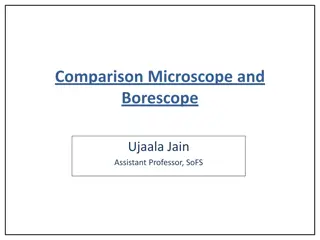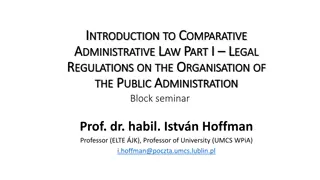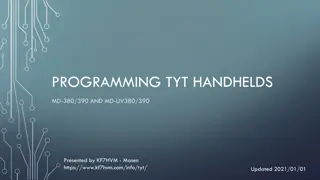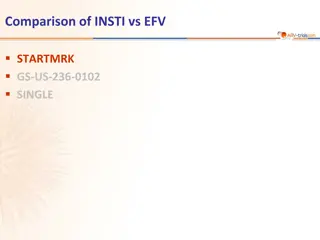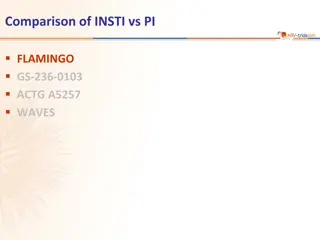
Comparison of INSTI vs. INSTI QDMRK in Study GS-US-380-1489
This study, GS-US-380-1489, investigates the efficacy of BIC/F/TAF versus DTG/ABC/3TC in HIV patients. It analyzes virologic outcomes, baseline characteristics, and patient disposition at week 48. Results show non-inferiority of BIC/F/TAF in achieving HIV RNA suppression. Details on participant demographics, virologic outcomes, and resistance testing are provided.
Download Presentation

Please find below an Image/Link to download the presentation.
The content on the website is provided AS IS for your information and personal use only. It may not be sold, licensed, or shared on other websites without obtaining consent from the author. If you encounter any issues during the download, it is possible that the publisher has removed the file from their server.
You are allowed to download the files provided on this website for personal or commercial use, subject to the condition that they are used lawfully. All files are the property of their respective owners.
The content on the website is provided AS IS for your information and personal use only. It may not be sold, licensed, or shared on other websites without obtaining consent from the author.
E N D
Presentation Transcript
Comparison of INSTI vs INSTI QDMRK SPRING-2 ONCEMRK GS-US-380-1489 GS-US-380-1490
Study GS-US-380-1489: BIC/F/TAF QD vs DTG/ABC/3TC QD Design Randomisation* 1 : 1 Double-blind W48 W144 > 18 years, ARV-na ve HIV RNA > 500 c/mL Any CD4 cell count HLA B*5701 negative eGFR 50 mL/min HBs Ag negative No resistance to FTC/3TC, TDF or ABC N = 314 BIC/F/TAF QD DTG/ABC/3TC placebo QD DTG/ABC/3TC QD BIC/F/TAF placebo QD N = 315 * Randomisation was stratified by HIV RNA (< 100 000 c/mL, 100 000-4000 000 c/mL or > 100 000 c/mL), CD4 (< 50/mm3, 50-199/mm3or 200/mm3) at screening and geographic region (USA vs non-USA) BIC/F/TAF: 50/200/25 mg, as STR Objective Non inferiority of BIC/F/TAF at W48: % HIV RNA < 50 c/mL by intention to treat, snapshot analysis (lower margin of the 2-sided 95.002% CI for the difference= -12%, 95% power) GS-US-380-1489 Gallant J. Lancet. 2017 Nov 4;390(10107):2063-2072 ; Wohl DA Lancet HIV 2019 ; 6:e355-63
Study GS-US-380-1489: BIC/F/TAF QD vs DTG/ABC/3TC QD Baseline characteristics and patient disposition BIC/F/TAF N = 314 DTG/ABC/3TC N = 315 Median age, years 31 32 Female, % 9 10 HIV RNA (log10 c/mL), median HIV RNA > 100 000 c/mL, % 4.42 4.51 17 16 CD4 cell count (/mm3), median 443 450 CD4 < 200/mm3, % 11 10 Discontinuations at W48 W48-W96 at W48 W48-W96 Total discontinuations, N (%) 19 (6%) 17 (5.8%) 16 (5%) 15 (5%) For lack of efficacy, N 0 0 0 0 For adverse event, N 0 0 4 1 Lost to follow-up, N 9 8 6 6 Non-compliance / Other, N 1 / 9 1 / 8 1 / 5 2 / 6 GS-US-380-1489 Gallant J. Lancet. 2017 Nov 4;390(10107):2063-2072 ; Wohl DA Lancet HIV 2019 ; 6:e355-63
Study GS-US-380-1489: BIC/F/TAF QD vs DTG/ABC/3TC QD Virologic outcome at week 48 % 93.0 100 92.4 BIC/F/TAF DTG/ABC/3TC Difference (95 % CI) 80 DTG/ABC/3TC BIC/F/TAF 60 - 0.6 40 - 4.8 3.6 20 + 12% 12% 0 6.7 4.4 2.5 Met criteria for resistance testing (HIV RNA 200 c/mL) BIC/F/TAF: 1 vsDTG/ABC/3TC: 4 No resistance emergence Mean CD4 increase at W48 BIC/F/TAF: + 233/mm3 DTG/ABC/3TC: + 229/mm3 1.0 0 HIV RNA < 50 c/mL HIV RNA 50 c/mL No data HIV RNA < 50 c/mL (per-protocol) BIC/F/TAF: 99.3% DTG/ABC/3TC: 98.6% GS-US-380-1489 Gallant J. Lancet. 2017 Nov 4;390(10107):2063-2072
Study GS-US-380-1489: BIC/F/TAF QD vs DTG/ABC/3TC QD HIV RNA < 50 c/mL at W48 according to baseline CD4 and HIV RNA, ITT-E snapshot BIC/F/TAF DTG/ABC/3TC % 94 94 100 94 93 90 87 83 81 80 60 40 20 261 265 53 50 278 283 36 32 N= 0 > 100 000 > 200 100 000 200 HIV RNA, c/ml CD4/mm3 GS-US-380-1489 Gallant J. Lancet. 2017 Nov 4;390(10107):2063-2072
Study GS-US-380-1489: BIC/F/TAF QD vs DTG/ABC/3TC QD Adverse events at W48 BIC/F/TAF N = 314 0 DTG/ABC/3TC N = 315 4 * Adverse events leading to study drug discontinuation, N Adverse event 5% in either group, % Diarrhea Headache Nausea Nasopharyngitis Cough Upper respiratory tract infection Fatigue Syphilis Insomnia Arthralgia Vomiting Bronchitis Abdominal pain Grade 3-4 laboratory abnormalities, % CK elevation LDL-cholesterol elevation Amylase Neutropenia * Nausea, rash ; thrombocytopenia ; chronic pancreatitis, steatorrhea ; depression ** p < 0.001 12.7 11.5 10.2 7.3 6.4 6.4 6.1 3.8 4.5 3.5 3.8 3.2 2.9 13.0 13.7 22.9 ** 9.2 2.5 10.8 8.6 7.9 6.3 6.0 5.4 5.1 5.1 3.5 2.3 1.9 1.6 3.3 2.6 2.2 3.2 GS-US-380-1489 Gallant J. Lancet. 2017 Nov 4;390(10107):2063-2072
Study GS-US-380-1489: BIC/F/TAF QD vs DTG/ABC/3TC QD Renal parameters, bone mineral density and lipid changes at W48 BIC/F/TAF N = 314 DTG/ABC/3TC N = 315 Median change in eGFR (Cockroft-Gault), mL/min - 10.5 - 10.8 Median percent changes in quantitative proteinuria, % Urine albumin: creatinine Retinol binding protein : creatinine Beta2-microglobulin : creatinine 0.6 14 - 23 6 20 - 18 Mean % changes in bone mineral density, % Hip Spine - 0.6 - 0.78 - 0.83 - 1.02 Mean changes in fasting lipids, mg/dL Total cholesterol LDL cholesterol HDL cholesterol Triglycerides None of the differences between groups were significant No discontinuations due to renal adverse events and no proximal tubulopathy in either arm 13 7 5 9 11 4 5 3 GS-US-380-1489 Gallant J. Lancet. 2017 Nov 4;390(10107):2063-2072
Study GS-US-380-1489: BIC/F/TAF QD vs DTG/ABC/3TC QD Steady-state pharmacokinetic parameters of BIC/F/TAF (N = 17) Bictegravir FTC TAF AUCtau (hr*ng/mL) Mean (% CV ; min-max 96 181.5 10 896.4 206.0 (33.5 ; 36 194-154 317) (29.8 ; 5 602.3-20 773.3) (51.2 ; 101.5-458.4) Cmax (ng/mL) Mean (% CV ; min-max) 6 704.7 1 868 225.5 (27.5 ; 3 550-9 550) (34.5 ; 822-3 220) (68.3 ; 73.3-713) Ctau (ng/mL) * Mean (% CV ; min-max) 2 311.7 * 80.9 - (40.7 ; 429-4 030) (37.1 ; 39.5-172.0) Tmax(h) Median (Q1-Q3) 1.53 (1.00-2.07) 1.50 (1.00-1.55) 0.53 (0.50-1.03) t1/2 (h) Median (Q1-Q3) 15.93 (14.50-17.78) 6.66 (6.32-7.17) 0.42 (0.36-0.49) * BIC mean Ctauabout 14 times higher than the protein adjusted effective concentration (162 ng/mL) against wild type HIV-1 virus GS-US-380-1489 Gallant J. Lancet. 2017 Nov 4;390(10107):2063-2072
Study GS-US-380-1489: BIC/F/TAF QD vs DTG/ABC/3TC QD Summary of week 48 results Initial HIV-1 therapy with BIC/F/TAF was non inferior to DTG/ABC/3TC at W48 by snapshot algorithm 92.4% of patients on BIC/F/TAF and 93.0% of patients on DTG/ABC/3TC had HIV-1 RNA < 50 copies/mL Sensitivity analyses confirmed non inferiority No treatment emergent resistance BIC/F/TAF was well tolerated, with no adverse events leading to discontinuation Nausea was reported significantly more frequently in patients treated with DTG/ABC/3TC (p < 0.001) Gastrointestinal, neuropsychiatric, and sleep-related symptoms were reported more frequently in patients treated with DTG/ABC/3TC Changes from baseline in bone mineral density, lipid parameters and renal markers were comparable between treatment arms GS-US-380-1489 Gallant J. Lancet. 2017 Nov 4;390(10107):2063-2072
Study GS-US-380-1489: BIC/F/TAF QD vs DTG/ABC/3TC QD Virologic outcome at week 96, ITT snapshot % 100 89.8 Difference (95 % CI) 87.9 BIC/F/TAF (N = 314) 80 DTG/3TC/ABC BIC/F/TAF DTG/3TC/ABC (N = 315) 60 - 1.9 40 11.5 - 6.9 3.1 7.9 20 0.6 2.2 0 HIV RNA < 50 c/mL HIV RNA 50 c/mL No virologic data -12 % 0 12 % Secondary endpoints at week 96 BIC/F/TAF DTG/3TC/ABC Per protocol 99.6% 98.9% HIV RNA < 50 c/mL (sensitivity analyses) Missing = failure 87.9% 90,8% Missing = excluded 98.9% 99.3% Virologic failure with confirmed HIV RNA > 200 c/mL N assessed for resistance N with emergence of resistance 0 0 5 0 Mean change in CD4 at W96 + 287/mm3 + 288/mm3 GS-US-380-1489 Wohl DA Lancet HIV 2019 ; 6:e355-63
Study GS-US-380-1489: BIC/F/TAF QD vs DTG/ABC/3TC QD Adverse events at W96 Discontinuation for adverse event BIC/F/TAF (N = 314) DTG/3TC/ABC (N = 315) 0 5 (1.6%) Nausea, rash (D4) Thrombocytopenia (D50) Chronic pancreatitis (D134) Depression (D248) Renal failure (D621) Adverse events all grades (%) BIC/F/TAF (N = 314) DTG/3TC/ABC (N = 315) Nausea 11 * 24 * Headache 13 16 Diarrhea 15 16 Fatigue 9 11 Insomnia 7 10 * p < 0.001 GS-US-380-1489 Wohl DA Lancet HIV 2019 ; 6:e355-63
Study GS-US-380-1489: BIC/F/TAF QD vs DTG/ABC/3TC QD Laboratory parameters (W96) BIC/F/TAF (N = 314) DTG/3TC/ABC (N = 315) p CK grade 3-4, % 6 5 - LDL-cholesterol grade 3-4, % 3 4 - Median change in eGFRCG, mL/min - 7.8 - 9.6 0.01 Median % change in urine albumine:creatinine ratio - 0.3 + 5.2 0.25 Median % change in urine retinol binding protein:creatinine ratio + 21.2 + 22.1 0.91 Median % change in urine beta-2- microglobulin:creatinine ratio - 30.8 - 29.4 0.96 Bone DXA: mean % change in BMD between D0 and W96 BIC/F/TAF (N = 314) DTG/3TC/ABC (N = 315) p Spine, % - 0.71 - 0.22 0.14 Hip, % - 1.13 - 1.26 0.59 GS-US-380-1489 Wohl DA Lancet HIV 2019 ; 6:e355-63
Study GS-US-380-1489: BIC/F/TAF QD vs DTG/ABC/3TC QD Mean changes in fasting lipids at W96, mg/dL Total cholesterol: HDL-cholesterol Ratio Total cholesterol LDL- HDL- Triglycerides cholesterol cholesterol p = 0.002 p < 0.001 p = 0.17 p = 0.28 p = 0.003 30 0.5 20 17 15 0 - 0.1 8 8 10 7 -0.2 6 5 -0.5 4 87,9 0 -1 Mean baseline value, mg/dL 159 162 101 101 42 42 93 96 3.7 3.7 BIC/FTC/TAF DTG/ABC/3TC % of patients on lipid-lowering agents at baseline 3.8 % 2.2 % % of patients initiating lipid-lowering agents during study 4.1% 3.8 % GS-US-380-1489 Wohl DA Lancet HIV 2019 ; 6:e355-63
Study GS-US-380-1489: BIC/F/TAF QD vs DTG/ABC/3TC QD Summary of week 96 results Initial HIV-1 therapy with BIC/F/TAF was non inferior to DTG/ABC/3TC at W96 by snapshot algorithm 87.9% of patients on BIC/F/TAF and 89.8% of patients on DTG/ABC/3TC had HIV-1 RNA < 50 copies/mL No treatment emergent resistance BIC/F/TAF was well tolerated, with no adverse events leading to discontinuation Nausea was reported significantly more frequently in patients treated with DTG/ABC/3TC (p < 0.001) Gastrointestinal, neuropsychiatric, and sleep-related symptoms were reported more frequently in patients treated with DTG/ABC/3TC Decrease in eGFR was significantly higher on DTG/ABC/3TC Increase in total-cholesterol and LDL-cholesterol was significantly higher on BIC/F/TAF, but the proportion of participants initiating lipid-lowering agents was not different between arms GS-US-380-1489 Wohl DA Lancet HIV 2019 ; 6:e355-63

